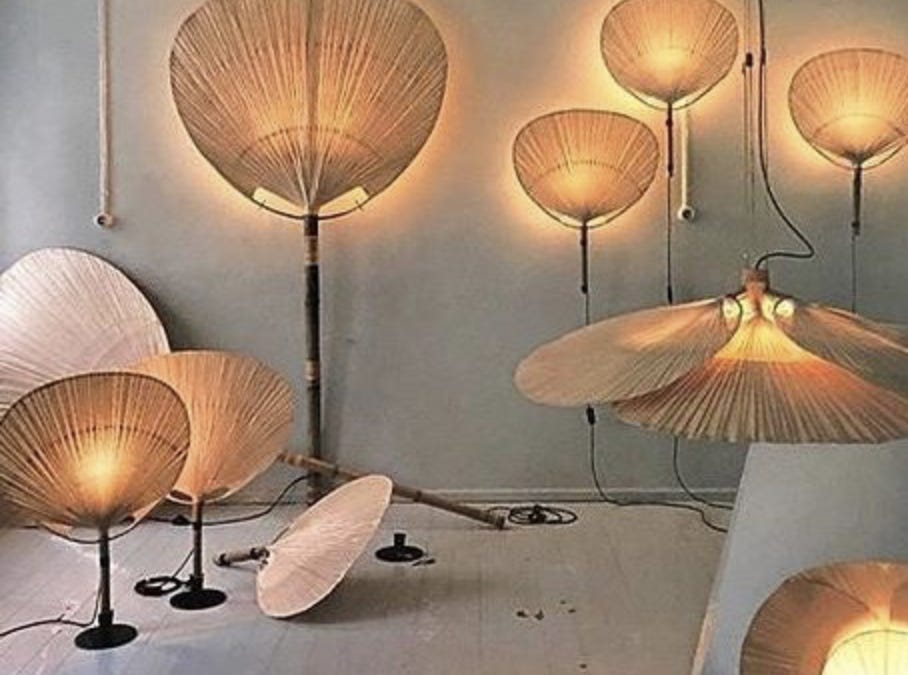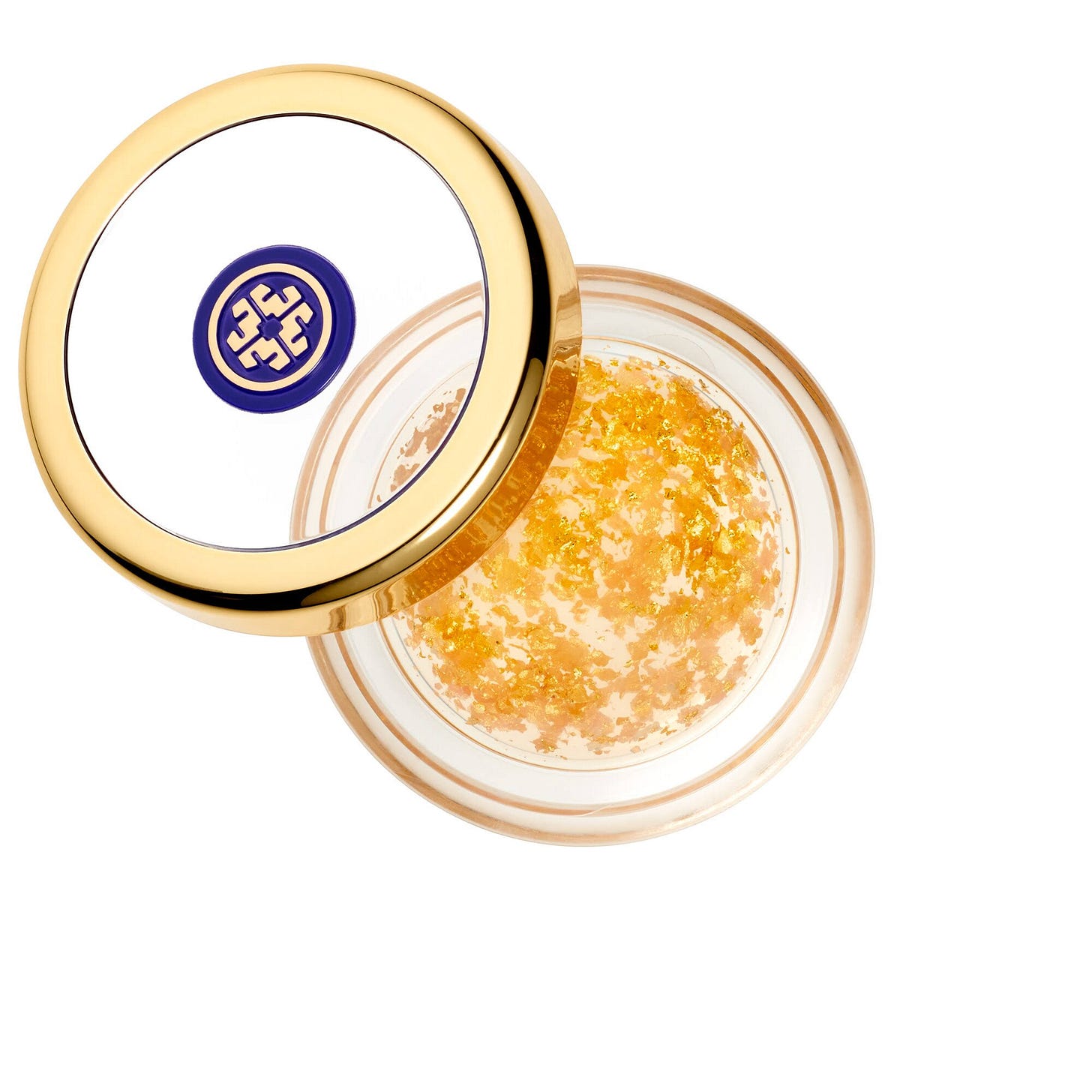I love lip balm. I have a slight paranoia about it because I suspect it’s one of those things where the more you use it, the more your lips need it, and if you stopped using it, you wouldn’t need it at all. I also seem to buy new lip balm precisely one week before the weather turns, and then I put it somewhere I can’t remember like in a coat pocket and discover it a year later, when winter rolls around again.
Ingo Maurer Uchiwa lamps.
The lip balm that is currently missing—and I’m certain it’s somewhere—was a gift from my Australian mother-in-law’s family, a Macadamia Nut lip butter or balm that I can’t seem to find online. It was sublime: thick, not greasy; insanely moisturizing but my lips never peeled after I used it; it had a slight yummy taste, but nothing too memorable or cloying. If any of you dear readers are from the Southern hemisphere and know what I am describing, tell me!
And yet, that’s the thing about lip balm. It is never not fun to try new lip balm. In general, I like to avoid anything with petroleum (that does include, sadly, Dr. Pawpaw’s or Rosebud Salve, even though the packaging is cool). In my opinion, there are two tranches of lip balm.
Kiehl’s Lip Balm #1, $10
The first tranche is your everyday lip balm. This is lip balm you keep in a coat pocket, in the bottom of a purse, by your laptop, in your car, your gym bag (what’s that again?), in your sweatpants that ends up getting thrown in the wash. This lip balm usually gets very banged up or dirty looking. It may acquire pocket lint. It may become deformed from your finger or from having sat sideways in your pocket. It is utilitarian, practical, no-nonsense lip balm. It should not be very expensive. You would appear logical to own multiples of this lip balm. This includes all drugstore lip balm, but my preferred balm in this category is Kiehl’s Lip Balm #1. Other candidates are Weleda Skin Food Lip Butter, Shisheido Water in Lip Moisturizing Lip Balm or Burt’s Bee’s Beeswax Lip Balm.
Tatcha Camellia Gold Spun Lip Balm, $30
The second tranche is an arbitrary category I’ve created that I like to call “pretty lip balm,” and this is lip balm you might idly leave by your bedside table or apply on a Zoom call because it feels a little more special. It is also more costly. It may promise unbelievable things. It often leaves a light gloss or it may be tinted. This includes Hermès, Tatcha, Augustinus Bader, La Mer, Omorovicza, Dr. Barbara Sturm, Olio E Osso, Linda Rodin’s Luxury Lip and Cheek oil, among many others. This is lip balm to buy for yourself on a glum day or to suggest as a present for yourself (I would say you could gift it, too, though I worry less discerning people would understand the decadence of such a gift. Use your best judgement, of course).
This tranche, of course, branches into two sub-tranches. The first is experimental lip balm, which includes UZ. UZ is a Japanese company that makes a lip treatment that uses some kind of lactic acid bacteria or probiotic (they've branded it as “Multi Flora”) that exfoliates your lips (I think), and it is true that after I use UZ, a layer of my lips peeled off. I was told this was a good thing. I found it a little too sticky but was nonetheless captivated. The second sub-tranche includes lip masks. I believe these were designed to be incorporated into an evening skincare routine. I am not someone who can be bothered to remember to wear a lip mask to bed but I have on occasion needed to feel like I was overpowering my lips with hydration, and I am a big fan of Tatcha’s, Laniege’s, and Henne’s. These are lip balms for when you’re feeling kind of extra and need to cultivate a sense of superiority with the world around you.
When I finished The Copenhagen Trilogy by Tove Ditlevsen, I had been lying in bed for what felt like days, dying of thirst, suffering from a light headache, in need of relieving myself, and unsure what time it was—I had been too captivated to do anything else but keep reading. This novel is presented in three acts, beginning with the narrator’s childhood, then moving onto her youth, and ending in her middle age. At first it is charming, strange. It starts to feel a little more optimistic by the time the narrator is able to have sex, but then it ultimately becomes horrifying and exhausting. I hesitate to say anything more because I read it without any introduction months ago, and want you to do the same. What got me was the stark language, the author’s own frankness when describing total and utter devastation, and her unsparing eye at life’s disappointments (of which there were many for a woman writer in the middle of last century). The final third is absolutely gripping and I simply cannot say anything more! It’s gotten a lot of hype, but it deserves it, so don’t let that deter you. Despite what I’ve just said, it is a beautiful work of writing. (And if you require a better sense of what the heck I’m talking about, try reading a professional—here are three critics I trust and adore: Hilton Als, Parul Sehgal, and Megan O’Grady.)
Baker’s Postscript
Behold, the lemon pound cake I baked a week or two ago. Stella Bugbee idly instagrammed a bundt cake and I immediately knew it had been made in a Nordic Ware pan and went to their website and shamelessly bought the exact same one. Coincidentally, my parents had just sent me a box of citrus from their yard (they have a beautiful Meyer lemon tree and if you live in California, I simply do not understand why you would not plant a Meyer lemon tree for yourself). So I got to make the most exquisite Meyer lemon pound cake using this Ina Garten recipe. I skipped the icing, but dusted it with powdered sugar to try and hide my overly buttered ridges.









